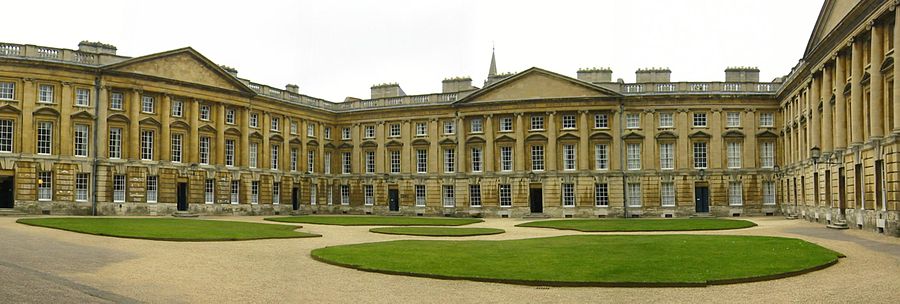| Main page | Indices | Projects |
The University of Oxford portal
The University of Oxford is a collegiate research university in Oxford, England. There is evidence of teaching as early as 1096, making it the oldest university in the English-speaking world and the world's second-oldest university in continuous operation. It grew rapidly from 1167, when Henry II banned English students from attending the University of Paris. After disputes between students and Oxford townsfolk in 1209, some academics fled north-east to Cambridge where they established what became the University of Cambridge. The two English ancient universities share many common features and are jointly referred to as Oxbridge.
The University of Oxford is made up of thirty-nine semi-autonomous constituent colleges, four permanent private halls, and a range of academic departments which are organised into four divisions. Each college is a self-governing institution within the university, controlling its own membership and having its own internal structure and activities. All students are members of a college. It does not have a main campus, but its buildings and facilities are scattered throughout the city centre. Undergraduate teaching at Oxford consists of lectures, small-group tutorials at the colleges and halls, seminars, laboratory work and occasionally further tutorials provided by the central university faculties and departments. Postgraduate teaching is provided in a predominantly centralised fashion.
Oxford operates the Ashmolean Museum, the world's oldest university museum; Oxford University Press, the largest university press in the world; and the largest academic library system nationwide. In the fiscal year ending 31 July 2023, the university had a total consolidated income of £2.92 billion, of which £789 million was from research grants and contracts.
Oxford has educated a wide range of notable alumni, including 30 prime ministers of the United Kingdom and many heads of state and government around the world. 73 Nobel Prize laureates, 4 Fields Medalists, and 6 Turing Award winners have matriculated, worked, or held visiting fellowships at the University of Oxford, while its alumni have won 160 Olympic medals. Oxford is the home of numerous scholarships, including the Rhodes Scholarship, one of the oldest international graduate scholarship programmes. (Full article...)
Selected article
The history of Brasenose College starts in 1509 when the college was founded on the site of Brasenose Hall by Richard Sutton and Bishop William Smyth. Its name is believed to derive from a bronze knocker (replica pictured) on the hall's door. The library and chapel were completed in the mid-seventeenth century, despite continuing financial problems. Under William Cleaver (Principal 1785–1809), the college began to be populated by gentlemen, its income doubled and academic success was considerable. New Quad was built between 1886 and 1911. Under Edward Hartopp Cradock Brasenose's academic record waned but it excelled at cricket and rowing; the reverse occurred under Charles Buller Heberden. Brasenose lost 115 men in the First World War and Lord Curzon's post-War reforms were successfully instituted. Sporting achievements again came at the cost of falling academic standards and finances. The 1970s saw the admission of women beginning in 1974, more post-graduate attendees and fewer domestic staff. Law and Philosophy, Politics and Economics were strong subjects under Principals Barry Nicholas and Herbert Hart) and the fellowship of Vernon Bogdanor. (Full article...)
Selected biography
Sir Bernard Williams (1929–2003) was an English moral philosopher, described by The Times as the "most brilliant and most important British moral philosopher of his time". He was the author of 11 books of philosophy, including Problems of the Self (1973), Moral Luck (1981), Ethics and the Limits of Philosophy (1985), and Truth And Truthfulness: An Essay In Genealogy (2002). He studied Literae Humaniores at Balliol College, Oxford before becoming a Fellow of All Souls College, Oxford. As Knightbridge Professor of Philosophy at the University of Cambridge and Deutsch Professor of Philosophy at the University of California, Berkeley, Williams became known internationally for his attempt to reorient the study of moral philosophy to history and culture, politics and psychology, and, in particular, to the Greeks. Oxford philosopher Gilbert Ryle once said of him that he "understands what you're going to say better than you understand it yourself, and sees all the possible objections to it, all the possible answers to all the possible objections, before you've got to the end of your sentence". (more...)
Selected college or hall
Selected image

Did you know
Articles from Wikipedia's "Did You Know" archives about the university and people associated with it:
- ... that the statue of the Virgin and Child in the porch of the University Church of St Mary the Virgin (pictured) was cited as evidence in Archbishop Laud's execution trial, and has bullet holes made by Oliver Cromwell's troops?
- ... that the great-granddaughter of Mahatma Gandhi, Leela Gandhi, is a senior lecturer at La Trobe University in the English program?
- ... that British Conservative MP Richard Hornby unsuccessfully challenged former Prime Minister and Labour leader Clement Attlee before securing a safe seat?
- ... that cyber law author and professor Jonathan Zittrain co-founded StopBadware.org to distribute the task of collecting data about malware to Internet users at large?
- ... that the military theories of the 18th-century Welsh soldier Henry Lloyd were studied by George Washington and George S. Patton?
Selected quotation
Selected panorama
Wikimedia
The following Wikimedia Foundation sister projects provide more on this subject:
-
Commons
Free media repository -
Wikibooks
Free textbooks and manuals -
Wikidata
Free knowledge base -
Wikinews
Free-content news -
Wikiquote
Collection of quotations -
Wikisource
Free-content library -
Wikiversity
Free learning tools -
Wikivoyage
Free travel guide -
Wiktionary
Dictionary and thesaurus













